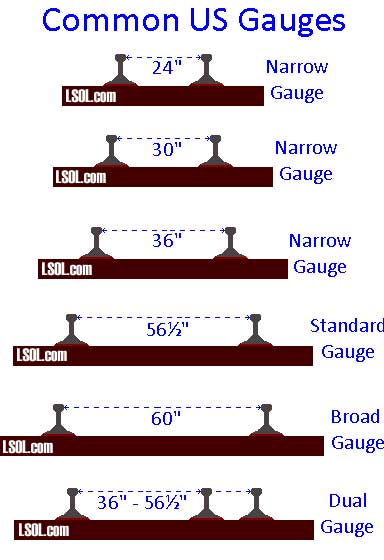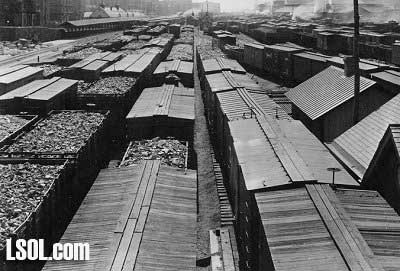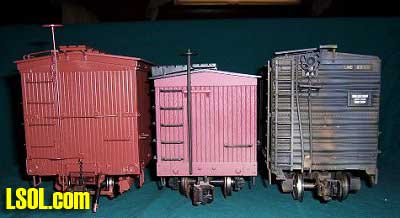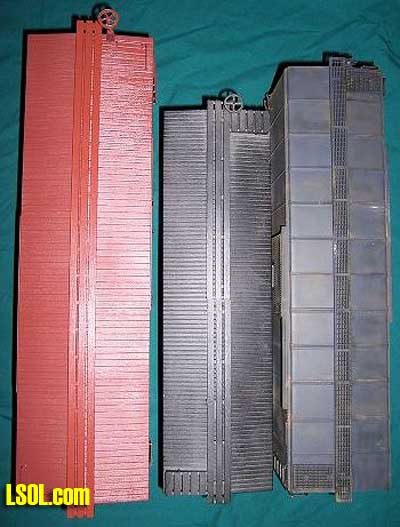Gauge & Scale
One Gauge, Many Scales, Much Confusion
Feb 25, 2009


By Rick Henderson
LSOL.com Associate Editor |
Author
Bio
It may take some time, but eventually, most everyone who gets into Model Railroading in G-gauge, which has been expressed as #1 Gauge, Garden Gauge, G-Scale, F-Scale and Large Scale along with a few other colorful nicknames, begins to finally understand the Scale and Gauge thing.
|
It may take some time, but eventually, most everyone who gets into Model Railroading in G-gauge, which has been expressed as #1 Gauge, Garden Gauge, G-Scale, F-Scale and Large Scale along with a few other colorful nicknames, begins to finally understand the Scale and Gauge thing. Those who seem to have the hardest time comprehending the issue are those who moved up from smaller modeling scales where everything is in the same scale but on different gauges of track. As my friend Don Niday states, "G is One Gauge, Many Scales, Much Confusion." To totally grasp the issue, you need to comprehend several key terms or words as they apply to railroading, both prototype and modeling. These words are broad, code, dual, gauge, narrow, scale and standard. Many people enjoying the hobby do not care about scale and gauge as long as their trains run and that is great; just being in the hobby is the main point. For the rest, I will explain what it all means. If you are still reading, we have come to the part where the twisted details are unraveled. Remember first that our models are based on prototype, real life, and full-sized trains. You may want to grab a drink, because this may get harder to understand. Lets first identify some of the basics in this numbers game called scale and gauge. There are three types of gauges in railroading, standard gauge, narrow gauge and broad gauge. Standard gauge was established in England in the 1800's as 4'-8 1/2" between the inside head of the two rails and the history of setting it to 4'-8 1/2" is another story and has many versions. Standard gauge is the gauge of over 60% of the world's railroads today. Broad gauge is any gauge wider than 4'-8 1/2" whereas narrow gauge is any gauge less than 4'-8 1/2". In Large Scale, G-gauge 45mm track can be representative of any of these prototype gauges. 
While we are speaking of the rails, let me explain rail codes (size). Prototype railroad rail is measured in pounds per yard or how much a 36" length of rail weighs. Rail size over the years has grown from 20 lbs per yard to over 155 lbs per yard. But in model railroading, rail sizes are expressed as code sizes, which is the rail height measured in thousands of an inch, with code-332 being the size of the most common G-gauge track. That means the rail is .332" or 1/3 of an inch tall.Modelers who are more concerned about the look of the seemingly over-sized G-rails, have taken the step of using a smaller code rail size, typically code 250 or even code 215 to obtain a more realistic looking track system. PDF DOWNLOAD - Rail Codes Since 155 lbs rail is about the largest used today in the US, code-332 rail for the scales of 1:32 & 1:29 is really too oversized to represent a realistic prototypical weight rail. The reason code-332 rail is so dominant in the hobby is its durability outside. When properly laid, you can walk on it. Smaller code rails are not as well suited. Therefore, the trade off for most modelers is that code-332 works best for most outdoors and its scale is overlooked. Now onto the little issue of Scales. Scale: n, the ratio between the size of something and a representation of it. The reason for the confusion about scale may go back to the early days when G was introduced into the U.S. from Germany as a very nice toy train offering. So nice in fact, that it caught the attention of modelers in smaller railroad scales, parents looking for Christmas trains, as well as many older folks that recognized how great these big trains would fit into a garden setting. G-scale was not first intended as a scale model, but when its excellent quality was recognized by modelers, a demand was created to expand into scale model trains. However, that part of the story is for other articles; we want to look at gauge and scales. When these trains first came out from Lehmann-Gross-Bahn, better known as LGB, in 1968, they were models of European one-meter narrow gauge trains. Meter-gauge is 39.37 inches or slightly wider than the common US three-foot narrow gauge tracks. The scale of these new trains was 1:22.5, meaning 1 inch on the model equals 221/2 inches on a real train. The gauge of 45mm track for this one-meter gauge model was selected from an existing track gauge used in another scale, that being the width of the old #1 gauge. #1 gauge was 1:32 scale for standard gauge. So basically, LGB took the existing track gauge already used in the scale of 1:32 and used that 45mm track width as the starting point of their new G-Scale line of 1-meter narrow gauge toy train line in 1:22.5 scale.
As the demand for American prototype trains in this new Large-Scale grew, LGB introduced the American Mogul style locomotive along with a few American style cars, all in 1:22.5 scale. As the line grew, since 1:22.5 scale did not equal anything common in US railroad history, modelers started asking for more accurate scales to be produced for the 45mm track and over the years, two scales became prominent in the American G culture, 1:29 and 1:20. Why 1:29 and not 1:32 became dominate as the scale for standard gauge is another long story, with no amenable resolution. While LGB may be passing into history, several companies are still producing in 1:29 and 1:20 to keep the G hobby strong and even growing. One reason given about the choice of 1:29 is that it was a compromise to work with multiple scales between 1:24 and 1:32 when the market was first evolving. The G-Scales or the Five Faces of G 
This is a rough size comparison of cars built to scale using 45mm track.
Basically, G-gauge has five different common scales [six if you add 13.7 for 2' gauge], all using the same size of track, (45mm width to the insides of the two rails). That 45mm is about 1?? inches or if you want to be more exact, it is 1.771". In recent years, and it is not just to confuse modelers, a second track gauge was introduced in 1:20.3 scale, which I will cover further on, however 99% of G is on the same 45mm track gauge. So now understanding the basic terms and a short history review of G-gauge, we understand that when using 45mm track, modeling in 1:32 scale is modeling prototypical standard gauge trains. The scale of 1:29 has also been deemed as acceptable as a standard gauge by sheer volume of product availability and the 10' rule [if it looks okay 10' away, it will work]. All other scales using 45mm track are narrow gauge scales of prototypical railroads. Therefore, 1:24 scale is for 42" gauge, 1:22.5 scale is for 1-meter gauge, 1:20.3 scale is 3' gauge and 13.7 is for 2' gauge.
What Scales are the Major Manufacturers?In review, on 45mm G-gauge track, 1:32 & 1:29 are scale models of standard gauge trains while the scales of 1:24 through 1:13.7 are all models of narrow gauge trains. The main large-scale model train manufacturers producing models in scales are: - 1:32 Standard Gauge Trains: Accucraft Trains Gauge 1, Marklin 1 Gauge, M-T-H RailKing
- 1:29 Standard Gauge Trains: Accucraft Trains (AMS) American Mainline Series, Aristo-Craft Trains, USA Trains Ultimate Series
- 1:24 Narrow Gauge: Accucraft Trains 1/2 Inch Series, Aristo-Craft Trains Classic Series, Bachmann Big Hauler Series, USA Trains American Series, HLW Trains
- 1:22.5 Narrow Gauge: Marklin-LGB
- 1:20.3 Narrow Gauge: Accucraft Trains Fn 3 Series, Bachmann Spectrum Series
- 1:13.7 Narrow Gauge: no major vendor
Do Railroads Run Different Scales? When you see different size railroad cars together, is it incorrect? Not always, given that all railroad cars were never built to the same exact plans. Go to a large freight yard, obviously not a coal or container yard, and browse over the lines of freight cars and you may be surprised to see the variety of car sizes. If a yard is not nearby, just browse the Internet. You should find that all cars are not the same, most noticeable in boxcar sizes. 
Are all cars the same scale in this shot of a 1910 freight yard? So is having multiple scales on one track a mistake? 
Do the three G-gauge car scales look so different from the 1910 photo? 
 Actually in the 1910 photo, they are all 1:1, it just looks like a lot of G-gauge yards. For the average hobbyist, the majority of those that are spending the money on G-gauge, absolutely not. As long as they stay coupled together they can be used together. Those that prefer to have one G-scale, have the option of picking the one scale they like and model only with equipment in that scale. The big reason we do not have one G-scale and multiple G-gauges of track available, as in the smaller scales such as 'O' and 'HO', is due to the very high cost of the track components that would be required. It is simply cheaper for manufacturers to produce one gauge of track and let modeler's choose their favorite scale to put on the track. So no, it is not a mistake, it is a necessary economic compromise. 
A 7 1/2" gauge Large Scale Track with multiple scales of trains.
Having multiple scales on one gauge is not unique to G-gauge. The original Large Scale railroads, what are really the "riding scales", have been around a lot longer than G-gauge and have multiple scales running on the same gauge of track with no complaint amongst the owners. On a 7 1/2" gauge track, you will find trains in 1:8, 1:7, 1:6, 1:5, and 1:4 scales running happily together for over 60 years now. Most of these railroads do not have much, if any, detailed scenery, which would make scale a more noticeable issue. By now you should see the scale thing is not that hard to comprehend once you appreciate that the track is always 45mm wide and the scales change based on the prototype railroad gauge you want to model. With that all clearly in mind, you can stop here or you can consider dual gauge railroads. Read my article, Introducing Dual Gauge in G
| Gauge and scale |
| That is a very good explanation of scale versus gauge. Especially where you point out who sells what. Also the rail size chart answers a lot of questions. Thank you for the article. |
| Glenn Habrial - 02/25/2009 - 05:33 |
| Naw, It's Scale and Gauge! |
| Rick, Well done. The article should serve to help folks understand what we deal with when playing with large scale. The PDF addition was a great idea. |
| JD Miller - 02/25/2009 - 05:40 |
| Scale & Gauge |
| Rick, Great article. Just what we need to clear up some of the confusion evident in some recent postings. Isn't LSOL.com wonderful. Great articles by great authors. The photos and charts are very useful. Thanks, Noel |
| Noel Widdifield - 02/25/2009 - 06:38 |
| Gauge and Scale |
| What a wonderful article! It must have taken a great deal of research to put it together. I appreciate this wealth of info! Thanks! |
| Ted Sutton - 02/25/2009 - 08:55 |
| Gauge & Scale |
| Great article, very well done! As a newbie to "G" scale it's very confusing to me (Spent 20 years in HO). Your article lays a lot of this confusion to rest. As Noel Widdifield stated the charts and drawings were very helpful. I might have to rethink the USA Passenger Cars in 1:29 being pulled by my 1:32 Accucraft Gs-4 Daylight engine |
| Dean Sheets - 02/25/2009 - 09:32 |
| Article Feedback |
| Glad it was helpful to many to better understand the G-hobby. It can confuse the most seasoned modeler... |
| Rick Henderson - 02/25/2009 - 14:20 |
| Article feedback |
| Super Job Rick! You made something that has been confusing me for years much more understandable. Now folks just need to make that personal decision on what scale to model in. I liken it to the old delema we had years ago... Should I go with VHS or Beta? With LGB's demise, we are back to taking a gamble on buying a scale that may ultimately become extinct. Thanks again. Great job! |
| Roland Smith - 02/25/2009 - 15:21 |
| Well said |
| Rick you said "...the scale thing is not that hard to comprehend once you appreciate that the track is always 45mm wide and the scales change based on the prototype railroad gauge you want to model." When trying to explain this to people I wish I could have said it that well. As a model builder since I was a very young child the whole concept of scale just makes sense to me, and it can be difficult to explain something when you understand it too well. You did a great job, thanks Rick |
| David A. Maynard - 02/25/2009 - 16:18 |
| scale and gauge |
| Great article,,first time I think I really understand the subject of scale and gauge. You explained it well enough that I think I could explain it to someone else,,,scary. Marcus |
| Marcus Boyd - 03/04/2009 - 16:38 |
| Gauge & Scale |
| Well done Rick on a very informative article. I knew a little of what you explained and reading you article filled the gaps nicely. You have done well to put people on the right track with your explanation. Dave |
| Dave Clarke - 03/27/2009 - 03:57 |
| just adding my own comments |
| Nice articles, great for those getting into the hobby to know. I would like to add that although LGB advertised thier scale ratio as 1:22.5, it seemed like they never really stuck to it. LGB wood side freight cars for instance are the same size as USA Trains American series woodside freight cars, making the LGB version more a 1:24 scale ratio. Even my hobby shop complained how LGB scale ratio was all over the place on different pieces. Also if you look up the scale ratio of 1:29 and 1:32 for G scale in Wikedia, it says that these gauges are Gauge #2 and not really gauge #1, but don't know why. My opinion is, bottom line no one will ever agree on a gauge or scale ratio being standardized as with one terminology word. I would also like to mention about Fn3 and the F scalers. The F scalers actually run Fn3 on gauge #1 track as narrow gauge, but run standard gauge on a 70.62mm wide track. The F scalers consider this the only true way to run a narrow gauge and mainline railroad on the same layout instead of keeping the same Gauge #1 track and just changing scale ratios. |
| Shawn Conahey - 04/08/2009 - 19:04 |
| Gauges and scales |
| Rick, Thanks for your most helpful article. I have some lgb gear from some years ago and am now re-engaging in the hobby. With the demise of LGB... it's necessary to decide on what scale to focus on going forward... this article has really helped. Gene |
| Gene Markiewicz - 08/29/2009 - 04:44 |
| Scale/Gauge |
| Rick, Thank You so much for the most indepth and easy to comprehend article on Scales and Gauges. The only time I have a real problem with this area is when I am buying other accessories, especially cars, trucks and other vehicles. I rarely find anything in either 1/28th or 1/29th scale. I see a lot of 1/24th and 1/25th scales. My qiestion is since 1/32nd is out of the question as it appears too small, is which is the best choise when buying accessories? |
| Gerry Keffer - 12/21/2010 - 15:39 |
| Scale/Gauge |
| Gerry, I find that for accessories the best is 1/24 or 1/25 since there are no 1/29 ones available. The 1/32 stuff looks too small next to the 1/29 locos and cars. All of the buildings that were purchased for my railroad are 1/24. The ones that I scratch built are 1/29. You can find many 1/29 or almost in figures. You just need to look. If you are interested in those, check out some of my articles on figures. Thanks, Noel |
| Noel Widdifield - 12/21/2010 - 17:55 |
| Scale Accessories |
| Gerry, Consider forced perspective and depth of field to make a scene work with multiple scale. If your trains are 1:29 then put 1:32 accessories on the far side of the track from the normal viewing. Don?t discount the 1:35 military models for further back. Then on your viewing side of the track, place your larger 1:24 and 1:22.5 scale stuff. As long as the scale get smaller as items are placed further away, it works. |
| Rick Henderson - 12/21/2010 - 20:05 |
| gauge & scale |
| when you buy engine are to be #1 gauge when you get it you find out its 1:32,i am into 1:29 gauge.also MTH engine dont operate with NCE equipment when you are told it does.now i am told you have to wait for protosound 3.0,which you cant buy. |
| daniel mariano - 10/29/2011 - 11:33 |
| Scale |
| THAT is by far the very best explanation and examples I have read about, EVER! Thank you for clearing up one of THE foggiest areas of model railroading in Large Scale..... |
| Gerry Keffer - 11/02/2012 - 14:23 |
Top of Page
|



